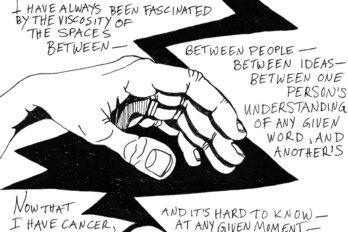It’s been a long day, but Elizabeth Croft is not going to miss a chance to demonstrate the wonders of science to a group of young women. Via live feed from the University of British Columbia, she’s introducing 150 female high school students at a conference in Castlegar, BC, to the robots in her lab—and the joys of her work. Cameraman in tow, she presents the first machine. Called RISER, it’s a device you try to balance on as it shifts beneath your feet. “We are all unstable inverted pendulums,” says Croft, at once an engaging tour guide and a nerdy mechanical engineer.
Next, one of her graduate students shows off a pair of modified controllers, part of a project that turns therapy for stroke and cerebral palsy patients into a game. To play, you must hold a controller in each hand and move the two in parallel to manipulate an onscreen cursor—no letting your strong side compensate for your weak one. Then comes Carla, a multi-purpose robotic-arm platform that Croft and her students are teaching to track moving objects.
But the star of the lab is PR2, a.k.a. Charlie, a plastic and metal humanoid with twenty-two degrees of freedom (your wrist has three, as Croft demonstrates, and your elbow one). Charlie accepts the water bottle proffered by a doctoral candidate and sets it smoothly on a stool. It can also hand the bottle back, and take an elevator from one floor to another. Eventually, says Croft, Charlie will enable elderly people to remain at home instead of in care.
Croft, associate dean for education and development in UBC’s Faculty of Applied Science, is a leading expert in assistive robotics. She believes robots like Charlie are the future. Computers can already detect signals in the human brain, which Croft believes will lead to “wearables that sense your mood” and respond accordingly. “Imagine a device—it might be your phone—that knows when you need some energizing music,” she says. “Or an autistic child, who is soothed by wrapping, in a sweater that senses when to comfort him.” Perhaps you’ll get home and merely wonder where you left your reading glasses. “Charlie will tell you,” says Croft, “or shine a light on them, or find them and bring them to you.”
Actually handing an object over is the dicey part, and robot safety has been the focus of Croft’s research for more than a decade. “It’s all about communication,” she says. “In the human-robot interaction, who cedes to whom? Motion planning. Space sharing. Turn taking. Collaborative lifting.” If a robot, helping in the kitchen, drops the butcher knife before you have a grip, or yanks it from you suddenly, there will be blood. Whose fault will that be? Beyond legal issues of liability, there’s a whole moral realm. Humans programming a machine to distribute painkillers might have conflicting ideas about pain thresholds, or about the morality of using narcotics. Robots might one day be capable of subjective, values-based decision-making—but who will program them, and with whose values?
One of the most well-known social robots is Paro, developed in Japan. Paro has the proportions and the big, dewy eyes of a harp seal pup; it responds to sound and touch, moves about, and even makes baby seal noises. It reduces patients’ stress, improves motivation, and facilitates socialization. Computer code passing as vital interaction may seem a bit creepy, but as aging baby boomers increasingly strain the health care system, it seems inevitable that some caregiving responsibilities will be delegated to machines.
Growing up in Vancouver, Croft imagined she’d be a physician. “Basically, I was going to be my mom,” she says. “But I realized I liked to build things. I was always playing with my brothers’ Lego, and I’d build these crazy Rube Goldberg contraptions in my bedroom. A UBC prof who was a friend of my parents noticed and said, Engineering—you might want to take a look at that. He was working on a Boeing aircraft at the time. I thought, Wow—people actually build these huge pieces of metal and they fly!”
Questions start rolling in from the Castlegar high schoolers: How many girls go into engineering? One of Croft’s passions (besides human-robot interaction, running, and exotic chocolate) is trying to draw women into the field, and she tells the girls that almost 30 percent of UBC’s first-year engineering class is female. When she entered the program in 1984, the proportion was about 13 percent. “Engineering,” she tells them, “is where you have a chance to make the world a better place.”
More questions: Where did Charlie come from? “It was built by a company called Willow Garage in California.” What’s the best part of your work? “This is the most fun job!” Croft answers. “I get to play with robots all day.”
Is Charlie, someone asks, a boy or a girl?
“Charlie,” says Elizabeth Croft, mechanical engineer, “moves on the gender spectrum.”
This appeared in the March 2015 issue.






